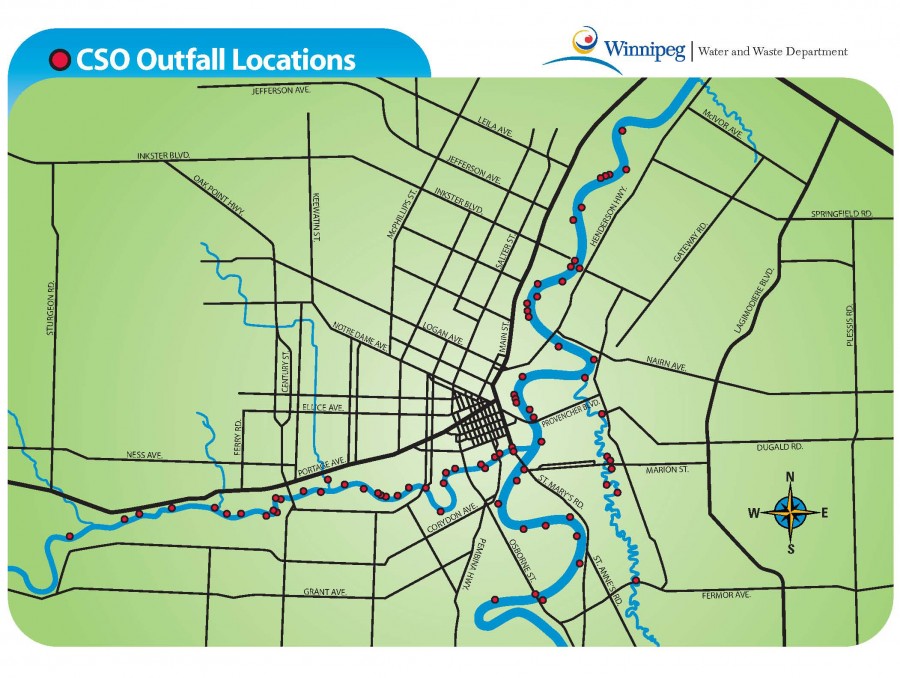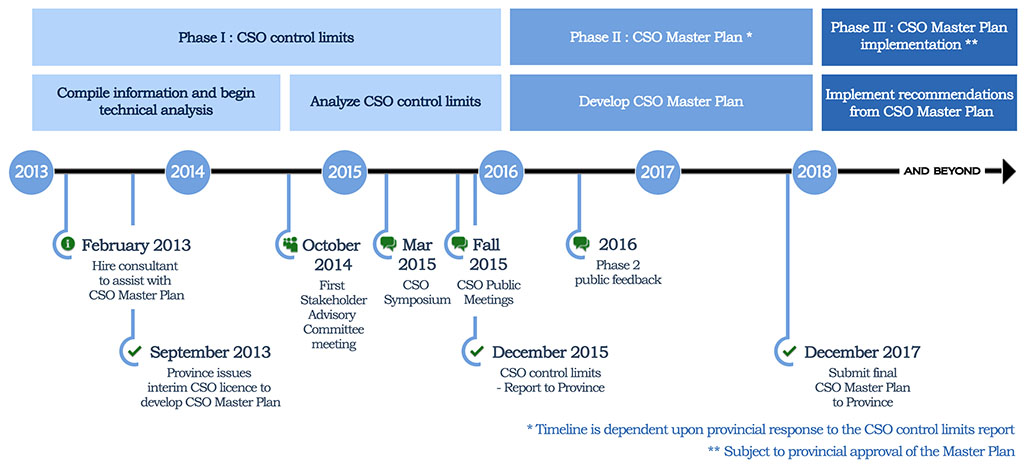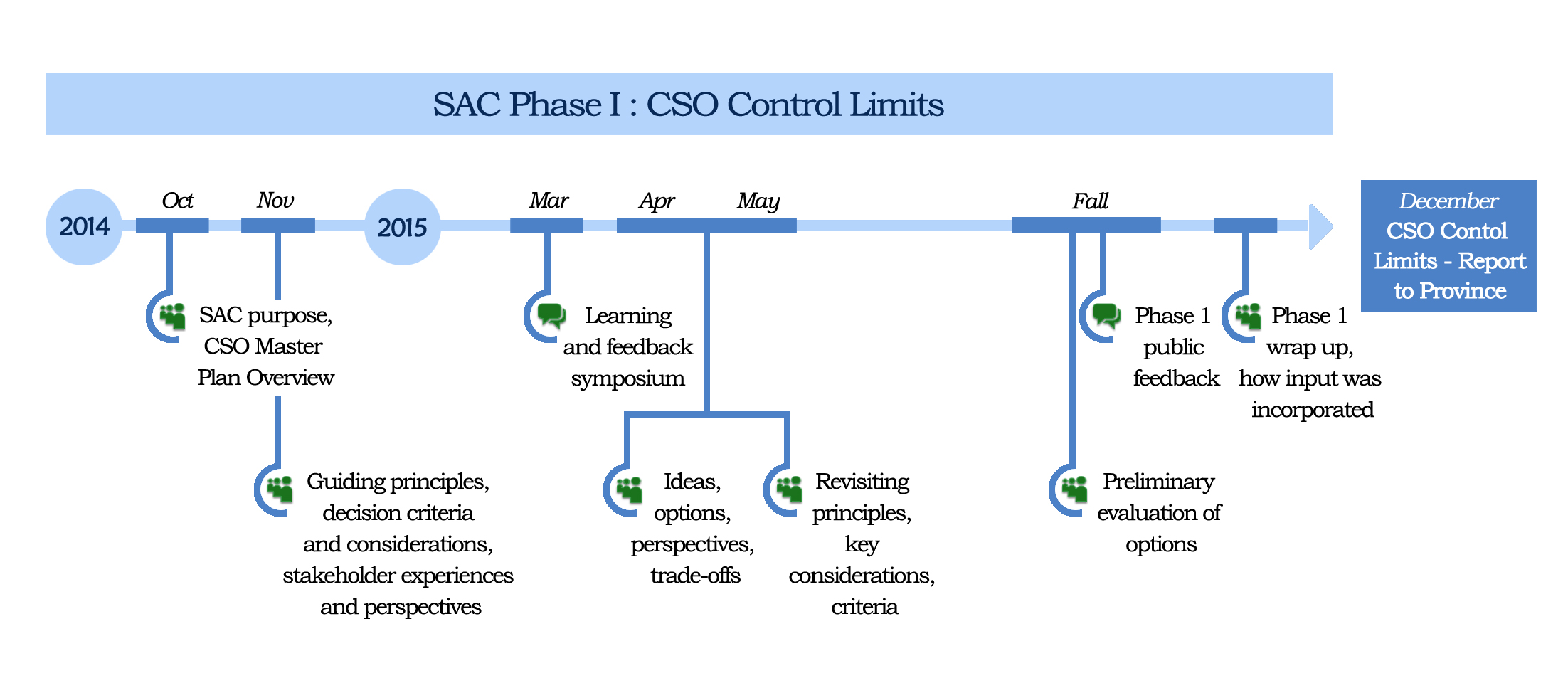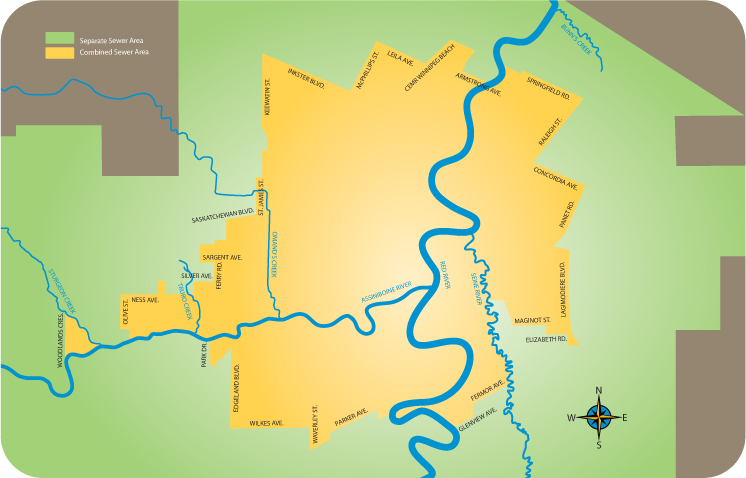Holiday season – View holiday hours for City of Winnipeg facilities and services from December 24 to January 1.
CSO Master Plan
Public input for this stage of the project is now closed.
Thank you for your feedback. We received feedback until October 5, 2015 through public meetings, a survey, emails, and comments on the website.
The results of our public engagement activities on this issue helped form the Preliminary Proposal, which was submitted to the Manitoba Government on December 18, 2015.
- Background
- Timeline
- Documents
- Links
- Stakeholder Advisory Committee
- Engage
- Updates
Background
We are developing a plan to manage the effects of combined sewer overflows (CSOs) on our rivers in an environmentally sound, sustainable and cost-effective manner.
Why does Winnipeg have CSOs?
The Winnipeg sewer system was originally a single pipe system combining all storm drainage, domestic and industrial wastewater in one pipe to the rivers. Today the single pipe combined system, which serves the older parts of the city, includes an interceptor system that carries all flow during dry weather to sewage treatment plants where it is cleaned and disinfected prior to being discharged to the rivers.
During wet weather events, the combined sewers system cannot handle all of the runoff that enters the system and it can flow at discharge points directly to the rivers.
These types of combined sewer overflows are common to older cities across Canada and worldwide. Since the 1960’s, cities, including Winnipeg, have been working to reduce these discharges.
What happens now?
We are working with consultants to develop a CSO Master Plan to set, and eventually achieve, control limits for CSOs to protect river quality. Developing a master plan includes:
- developing a hydraulic computer model of the combined and sanitary sewer system for the entire city,
- exploring standards and CSO control solutions in other cities,
- water quality and flow monitoring,
- identifying and evaluating cost effective control options,
- investigating potential pilot studies to test the effectiveness of CSO control options and how well they work in Winnipeg.
The CSO Master Plan will:
- identify and evaluate CSO control limits,
- provide a basis for responding to Provincial Environment Act Licence No. 3042,
- integrate work done to date and enhance our knowledge of the sewer system,
- recommend a long-term sustainable plan to reduce CSOs.
We will work with stakeholders to get their input on how to make choices and decisions about CSOs that meet licence requirements, our collective needs, and help us achieve the outcomes and future we want together.
Documents
Reports
- CSO Master Plan Preliminary Proposal
- Phase 1 Public Participation Report
- 2002 CSO Study Executive Summary
- Glossary of Terms
- CSO Master Plan Symposium Feedback Report
- Public Meetings Questions & Responses
Library
- CSO Public Meeting invitation (September 2015)
- Press release: Winnipeggers invited to provide feedback on how to limit combined sewer overflows (September 2015)
- CSO Public Meeting Presentation (September 2015)
- CSO Public Meeting Storyboards (September 2015)
- CSO Public Meeting advertisement (September 2015)
- CSO Symposium invitation (February 2015)
- CSO Symposium poster (February 2015)
- Press release: Winnipeggers invited to give input on a cost-effective strategy that will protect our rivers and lakes (February 2015)
- CSO Symposium advertisement (February 2015)
- Comments
Stakeholder Advisory Committee
As part of our public engagement strategy, we have brought together a Stakeholder Advisory Committee to share their perspectives and help us develop a Combined Sewer Overflow Master Plan to protect the health of our waterways, and moves forward in a way that reflects the values of Winnipeg families, the business community and river users. We will incorporate stakeholder input in our decision making process to the maximum extent possible.
| Chalmers Neighbourhod Renewal Coalition of Manitoba Neighbourhood Renewal Corporations (Winnipeg) |
Dale Karasiuk |
| International Institute of Sustainable Development | Hank Venema |
| Lake Friendly Stewards Alliance Partnership of the Manitoba Capital Region |
Colleen Sklar |
| Manitoba Eco-Network | Megan Krohn |
| Manitoba Heavy Construction Association | Chris Lorenc |
| Manitoba Conservation and Water Stewardship (Environmental Compliance and Enforcement) | Yvonne Hawryliuk |
| Manitoba Conservation and Water Stewardship (Environmental Approvals) | Siobhan Burland Ross |
| Manitoba Conservation and Water Stewardship (Water Quality) | Joy Kennedy |
| Old St. Vital BIZ | Colleen Mayer |
| Rivers West | Julie Turenne-Maynard |
| Winnipeg Chamber of Commerce | Carmine Militano |
Timeline
Meeting Presentation and Notes
Meeting #4 – April 9, 2015
Meeting #3 – January 28, 2015 Meeting #2 – November 19, 2014 Meeting #1 – October 2, 2014Engage
- Public Meetings
September 14 & 15, 2015 - CSO Master Plan Symposium
March 5: 2015
Updates
18 Jan 2016
We want your feedback! Open house on January 28th
You're invited to attend an open house to view proposed concept designs for the next phase of improvements in the North East Exchange District. This includes the new design for John Hirsh Place, in preparation for the 2017 Canada Games and coordinating infrastructure improvements over the next ten years.
Part of these plans include innovative efforts to reduce combined sewers and their impacts as well as pilot green infrastructure like we have outlined in the Preliminary Proposal of the CSO Master Plan, which we recently submitted to the Manitoba Government.
Most of the street's drainage will be diverted into underground soil storage cells. During severe storms, excess water will enter the combined sewer. However, in most cases, the excess water will have a chance to be cleaned through the soil. The performance of this pilot project will be monitored to determine the costs and benefits.
A detailed design will be completed this winter, followed by construction beginning in the spring.
We want to hear your questions and feedback as we know that this is the best way to support the evolution of this vibrant area. The meeting will be held:
Date: Thursday, January 28, 2016
Time: 4:00 p.m. to 7:00 p.m. (drop-in format)
Location: Pantages Playhouse Theatre, 180 Market Avenue
If you cannot attend and would like to provide your input or you would like more information on this project, please visit the project website at www.winnipeg.ca/northeastexchange or contact Ryan Segal, MMM Group at 204-943-3178 or at segalr@mmm.ca.
15 Jan 2016
CSO Master Plan Preliminary Proposal and Recommendation
On December 18, 2015, we submitted the CSO Master Plan Preliminary Proposal to the Province, including our recommendation of what control limit to set for combined sewer overflows (CSOs).
Setting a control limit is an important measure to protect our river quality by controlling the flow from sewers to the river.
Using your feedback, peer reviews and technical evaluations, we came to the recommendation of capturing 85% of combined sewer overflows during wet weather.
We have posted the preliminary proposal online here, which includes an overview of the alternatives, technical evaluations, performance assessments, and rationale for the recommendation.
Key points in preliminary proposal include:
- Our recommended level of 85% combined sewer overflow capture is a recognized benchmark for CSO control programs.
- We currently capture and treat 74% of combined sewer overflow.
- Only 0.3% of the nutrients currently going into Lake Winnipeg are from CSOs, which would decrease to about 0.1% with an 85% CSO capture.
- The recommendation of 85% is flexible and can be revised to reflect changes in the environment or future regulations.
If the Province accepts the recommendation, we will begin phase two: CSO Master Plan Development.
11 Sep 2015
How are CSO controls measured?
There are two ways to measure the impact of CSO reductions:
- reducing the frequency, or number of occurrences, of untreated overflows, which relates to the number of days the river has high bacterial counts; and
- reducing the volume of untreated sewage entering the river, which relates to the total amount of nutrients entering the rivers.
Reducing the number of overflows and reducing the volume of those overflows are not the same, and they have different impacts.
For example, in a given year, there might be 10 overflows at a total volume of 100,000 litres (at an average of 10,000 litres each). The next year, during a stormy season, there might only be 2 overflows—but due to the magnitude of those storms, they reach a total volume of 120,000 litres (at an average of 60,000 litres each).
In these scenarios, reducing the number of overflows by one in the first year would not have as big of an effect on total volume as it would in the second year. We consider both the volume and frequency of overflows when trying to control them.
09 Sep 2015
What are the potential ways that we can implement CSO control strategies?
There are numerous ways in which combined sewer overflows strategies can be implemented. In most cases CSO control strategies incorporate numerous components of grey and green infrastructure, both large and small scale projects, and smaller targeted improvements.
One approach to implementing control strategies is to tackle the smaller, more cost-effective control options first. These include solutions such as:
- Disconnecting downspouts
- Retaining water on site with bio-swales or landscaping
- Optimizing weirs and pumping strategies in the CSO districts
- In-line storage options
- Encouraging the use of rain barrels
- Sewer separation
- Storage tunnels
- Treatment plant upgrades
When implementing a new strategy for controlling CSOs in Winnipeg, time is needed to assess the performance and value of approaches. Pilot studies are also required to test and appraise new technologies or approaches not previously undertaken in Winnipeg. This will allow for a flexible strategy that can be continually revised to optimize its effectiveness.
07 Sep 2015
What would happen if we fully separated sewers?
Combined sewer systems are designed to collect both land drainage (rainwater and snowmelt) and wastewater (sewage from homes and businesses) in the same pipe. Right now, combined sewers make up 32% of the total sewer system.
If we fully separated our sewer system from land drainage systems, there would be positive impacts, but also potentially some negative ones.
In terms of the positive impacts, less wastewater and land drainage would be directed to our sewage treatment plants during rainy or melting periods. This would increase our plants' capacity and lower their long-term maintenance and treatment costs.
Another benefit would be that it would reduce the occurrences of sewer backup and basement flooding. It will also have a positive impact on water quality, reducing the instances of bacteria spikes and eliminating combined sewer sanitary floatables from entering the river.
On the other hand, there would also be negative impacts to having fully separated sewers. First of all, full separation would be extremely expensive, since nearly one in three of our sewers are combined and would have to be replaced or upgraded.
Second, it would take a very long time to carry out, since most full-separations need to be coordinated with other infrastructure projects like road renewals. This would result in disruption to traffic during the upgrades, which would impact neighbourhood services. This would especially affect the traffic in the downtown area, where nearly every street would need to be dug up to lay additional separate sewer pipes.
03 Sep 2015
How does the implementation time impact the CSO Master Plan?
Implementing control strategies quicker allows for benefits to be realised sooner. However, the time it takes to implement the CSO Master Plan can significantly impact other aspects of the project.
The greatest impact of a more rapid implementation of the plan would be on affordability, where a shorter timeframe to implement the plan would result in larger utility bill increases. Other factors, which also impact cost, need to be considered in determining the implementation time frame: local economic conditions, availability of contractors, construction inflation, community disruption, and capital budget constraints. These may limit the amount of work possible in a specific timeframe.
To make best use of available resources, implementation should be coordinated with other infrastructure projects, which would normally happen over an extended period of time. For example, implementing a control strategy like sewer separation could be coordinated with scheduled road repairs.
Implementing the CSO Master Plan in a phased approach provides time to learn how different control strategies impact the system. Future phases can then be improved from experience gained from previous phases, enhancing the program based on what has been demonstrated to work. For example, screening equipment that may work well in another city may not perform well during Winnipeg's winter months. Taking the necessary time to learn how previously implemented control strategies impact the system will ensure that future phases of work carried out will optimize the use of resources.
01 Sep 2015
Does reducing CSOs have an impact on the sewage treatment plants?
If we diverted all runoff from the CSO districts to a sewage treatment plant with our current infrastructure, it would have such significant impacts that it would be difficult to manage.
First is the issue of capacity. Runoff collected during heavy rainfalls would be much greater than the current system capacity. Currently, there is not enough capacity to transport all the sewage and runoff to the treatment plants, nor the capacity to treat it once it arrived.
It is still possible that all runoff could be diverted to the sewage treatment plants before being released into the rivers. However, this would require changes or upgrades to our existing treatment plants. One option would be to temporarily store the combined sewage at its source, and then gradually send it to treatment. Even with this option, more upgrades to our treatment plants would be required.
27 Aug 2015
How does the CSO Licence fit with the other Environment Licences issued by the Province of Manitoba?
Major sewer projects, as well as the CSO Master Plan, are regulated through the provincial government by environment licences. Each of the projects associated with the different licences have significant costs associated with implementing them:
West End Sewage Treatment Plant
To increase our capabilities of removing biological nutrients such as nitrogen and phosphorus, we undertook upgrades to the West End Pollution Control Centre. These were completed in 2010. The total cost was $33 million, of which we contributed nearly $20 million. This project was regulated under Manitoba Environment Act Licence No. 2669ERR.
South End Sewage Treatment Plant
The South End Sewage Treatment Plant is being upgraded to improve its ability to remove biological nutrients. In addition, the plant's capacity is increasing to accommodate the number new customers in the area. The City is paying for approximately $276 million of the total $335 million cost. This project is regulated under Manitoba Environment Act Licence No. 2716RR.
North End Sewage Treatment Plant
The North End Sewage Treatment Plant recently underwent two major upgrades. The first was to use UV light to disinfect wastewater and reduce pathogens, which was completed in 2010. Second was to add centrate treatment to remove nutrients, which was competed in 2011. The next upgrade, which is still in the planning stages, is to improve nutrient removal with a biological process. The total of this upcoming upgrade will be in the range of $569 million, with our contribution estimated at $374 million. These projects are regulated under Manitoba Environment Act Licence No. 2684RRR.
Biosolids Management Program
The City recently submitted a 30-year Biosolids Master Plan to the Provincial Government for their approval. It will focus on managing biosolids, which are soil-like by-products from the wastewater treatment process. The goal is to handle or dispose them in an environmentally sound, sustainable manner while meeting regulations. It is estimated that the cost will be in the range of $274 million – the entirety of which would come from the City of Winnipeg. This project will be regulated under Manitoba Environment Act Licence No. 1089ERR.
The costs for these projects are split between the City, Provincial, and Federal Governments. Because not all of these projects can be implemented or funded at once, we have to balance and prioritise parts of these projects.25 Aug 2015
How does the CSO Master Plan fit into other City priorities?
The CSO Master Plan is a plan that will help us do our part to protect the long term health of our rivers and lakes. The City is committed to developing a plan to reduce the effects of CSOs on our rivers in an environmentally sound, sustainable and cost-effective manner.
As with most infrastructure projects, the implementation of CSO control strategies must be balanced with other competing infrastructure priorities that face our City, including other projects governed by Provincial Environmental Licences. Ultimately it is the City's Capital Budgeting process, which is approved by Council, will lead to projects moving forward towards implementation. Historically the City manages new and ongoing capital project based on this available budget.
Many factors are considered by Council when deciding which projects will get funding. Some example factors include cost, regulation compliance, environmental benefit, financial benefit, potential integration with nearby projects and timelines.
19 Aug 2015
What are local businesses and industries doing to help address CSOs?
Addressing CSOs needs everyone to do their part, including local businesses and industries.
Wastewater discharges are regulated by the City of Winnipeg's Sewer By-Law 92/2010, along with other Provincial regulations. The Sewer By-Law outlines strict restrictions on what businesses and industries are allowed to discharge into the sewer and land drainage systems by setting specific limits on the concentrations of chemicals, metals, and other substances. It also encourages treatment of wastewater at the source, before it enters the sewer system.
Some businesses are also subject to specific measures that keep harmful materials from entering the sewer system. For example, grease traps are required for commercial kitchens. Up-to-date records of maintenance activities for these traps must be kept, and inspections are conducted to ensure by-laws are being followed.
The City also works with developers to ensure that flows from new developments do not increase the volume or frequency of combined sewer overflows. Many developers already work to reduce their impact by restricting their runoff.
04 Mar 2015
How will implementing CSO control strategies impact my neighbourhood?
The amount of construction in a combined sewer area depends on the control strategies used. Most construction activity will likely cause only localized traffic disruptions, such as is common for current sewer renewals.
Some control strategies like end-of-pipe treatment could cause minimal disruption, while others involving local storage could involve closing traffic on some local streets. More extensive strategies, like sewer separation could involve sewer construction on potentially every street throughout a neighbourhood.
The potential impacts in a specific neighbourhood will be brought back to the public as we proceed with implementing the CSO Master Plan – Phase 3 of the project. Through this process we will determine what will work best on a neighbourhood, or sewer district, basis. It is expected that control measures will be implemented over time and will approved as part of the Capital Budget process.
Will there be any impact on the economy?
When carrying out major infrastructure work, several factors can potentially constrain implementation. Constructing CSO control strategies would be just one piece of many different projects that a limited budget would fund. Council approves the capital budget and determine priorities for the City.
The local construction industry also has a finite capacity to build the solutions once designed. Requiring implementation in a shorter period of time could increase costs because of this limited capacity.
03 Mar 2015
How much will it cost to reduce CSOs?
The cost of implementing CSO control strategies will depend on various factors, including the level of control CSOs will be regulated to meet, the control strategies selected, and the timeframe over which the Master Plan is implemented.
Estimates found in the 2002 CSO Master Plan the cost ranged from $129 million to $1.5 billion in 2001 dollars. In today's dollars those amounts range from $500 million to over $2 billion. The new CSO Master Plan is looking at a broad range of control strategies in more detail and will update these estimates, and will factor in social, environmental and economic factors.
The CSO program has the potential to be one of the largest, if not the largest, capital program initiatives the City has ever undertaken. Affordability is of high concern and will be a major consideration in evaluating the decisions being made.
Funding for combined sewer upgrades in Winnipeg has usually been through sewer rates through utility bills. To ensure that the program remains affordable alternate sources of funding may be considered, such as receiving funding assistance from other levels of government. The CSO Master Plan will assess cost throughout the project and will present them as part of the options being considered.
02 Mar 2015
How do CSOs impact our rivers?
CSOs discharge diluted wastewater into the rivers that can result in visible floatables, such as floating debris. There is also the potential for odour when the volume discharging into the rivers is great enough. In order to address these problems, localized solutions like screens or air exhaust filters are normally used.
CSOs do not affect the rivers' colour, as Winnipeg's rivers are naturally murky brown in appearance due to the large amounts of suspended soils in the water.
There are two key environmental criteria* for CSOs to help ensure a healthy river system:
- Dissolved Oxygen (DO) is important for protecting aquatic life. Levels of DO has been shown to be relatively unaffected by CSO events, and have remained consistent the levels required to sustain a healthy aquatic system.
- Ammonia can be toxic to aquatic life and organisms in the water, depending on its concentration. CSO events are not a significant factor in ammonia levels in the river, and do not approach levels harmful to aquatic life.
Water quality is monitored at regular intervals during the open water season to measure the health of Winnipeg's waterways. Monitoring is done at various locations along the Red and Assiniboine rivers, as well as on selected small streams. Seventeen parameters are tested for, including nutrients, dissolved oxygen and bacteria.
Winnipeg is a "river city" used by many throughout the year. The rivers are a valued resource and key aspect of our city, which contributes to the quality of life. The Red River supports a valued sport fishing industry. Any improvement to the aesthetic or biological qualities of the rivers would increase their social, environmental, and economic potential.
Are CSOs a public health risk?
While CSOs can be aesthetically unattractive, bringing floatables to the rivers, they pose very minimal risk to public health. While CSOs can have an impact on the fecal coliform concentrations in the rivers, natural die-off causes the elevated coliform levels to return to normal in about three to four days, depending on river temperature, sunlight, and other factors. While these "spikes" in fecal coliform may degrade recreational water quality for short durations, water testing done after CSOs* have shown the levels after storm events do not pose health risks to river users.
The Chief Provincial Public Health Officer with the Winnipeg Regional Health Authority advises:
Never drink river water, whether overflows are occurring or not. Do not swim in the river system at any time because of fast currents, cloudy water, and slippery, muddy banks. Wash your hands if they come in contact with river water, particularly before you touch food. * 2002 City of Winnipeg CSO Study
27 Feb 2015
How does the CSO Master Plan align with OurWinnipeg?
OurWinnipeg, and its associated document, Sustainable Water and Waste Directional Strategy, guide the growth and change for the City. The strategy addresses environmental, economic and social sustainability and provides a path to guide infrastructure needs into the future.
The CSO Master Plan is a component of the Sustainable Water and Waste Directional Strategy (4-3c).
There are other specific policies that connect with the Plan, which also may affect the choice of CSO control strategies. The sewer renewal program (4-4b) is integrated with CSO work, where system capacity is increased. Strategies that reduce runoff using natural amenities (6-3), such as water sensitive urban design (6-3a) and land drainage retention facilities (6-3b), will also continue to be promoted.
26 Feb 2015
What are the effects of CSOs on Lake Winnipeg?
Lake Winnipeg has a very large watershed that drains Alberta, Saskatchewan, Manitoba, Northwest Ontario, North Dakota, South Dakota, Montana and Northwestern Minnesota. The drainage area exceeds 982,000 km2, where much of it is intensively cultivated agricultural lands. Many cities (e.g. Calgary, Edmonton, Regina, Brandon, Kenora, Grand Forks, and Fargo) drain to the watershed, before it makes its way to Lake Winnipeg.
High levels of nutrients in Lake Winnipeg, like phosphorus and nitrogen, cause excessive algae and weed growth. This lowers water quality, harms fish and other aquatic life as a result of lower oxygen levels, and affects the appearance and recreational enjoyment of our rivers and lakes.
Phosphorus and nitrogen are essential components of a healthy ecosystem. Virtually all human activities can introduce new sources of nutrient to aquatic systems. Lake Winnipeg is estimated to receive 63,207 tons a year of total nitrogen (TN) and 5,838 tons a year of total phosphorus (TP)*.
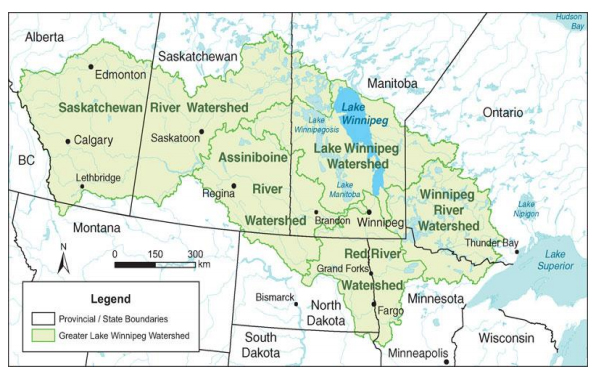
Copyright: WildernessCommittee.org
In 2002 a long term report* looked at river monitoring data between 1994 and 2001, estimating total nutrient contributions from different sources to Lake Winnipeg. (*A Preliminary Estimate of TN and TP Loading to Streams in Manitoba, 2002 ).The approximate contributions from the City of Winnipeg to Lake Winnipeg are 5.7% TN and 6.7% TP 6.7, which includes the three wastewater treatment plants, land drainage and CSO discharges. The report estimates that Winnipeg CSOs only make up 79 tons a year or 0.1% of TN, and 16 tons a year or 0.3% of TP.
For further information on nutrient loading to Lake Winnipeg, please visit the Province of Manitoba's website .
*A Preliminary Estimate of TN and TP Loading to Streams in Manitoba, 2002
25 Feb 2015
How do CSO control strategies impact basement flooding?
Heavy rainstorms result in large volumes of runoff and can overwhelm combined sewer systems. Overloaded sewers can back up through house sewer lines and flow into basements that aren't protected. Any additional water removed from the system through using CSO control strategies may result in decreased basement flooding.
CSO control strategies either delay the runoff entering the system or remove it entirely. The type of CSO controls used can affect how much runoff is delayed or removed, which in turn determines the amount of additional flooding protection a basement receives. We will look for opportunities to reduce the risks of basement flooding when implementing CSO control strategies, and will not use strategies that would increase the risk of basement flooding.
24 Feb 2015
How does development impact CSOs?
Development in combined sewer districts can potentially increase the amount of impervious surfaces, such as laying concrete on previously grassy areas. Impervious areas reduce the rate at which water soaks into the soil, increasing the amount of runoff entering the combined sewer system, increasing CSOs.
There are development regulations in place so that runoff entering the combined sewer system is reduced. For example, developments must submit calculations demonstrating that post-development site runoff will not exceed pre-development runoff. Sites greater than 10,750 square feet must have an internal land drainage system that follows strict guidelines; ensuring land drainage runoff (rain and snowmelt) is retained on site during peak flows.
There are also a range of green infrastructure runoff control strategies that have been used successfully in other municipalities to achieve sustainable runoff performance.
23 Feb 2015
What can I do to help reduce CSOs?
There are several things you can do around the home or at your business to help reduce CSOs:
- Use rain barrels to capture rain from downspouts, reusing it to water gardens and lawns.
- Plant trees, shrubs, and other vegetation; the roots help absorb excess water and the leaves help to delay rainwater from reaching the ground.
- Improve how water is absorbed and filtered into the ground by maximizing green space, using soil amendments like compost
- Introduce rain gardens or bioswales in low-lying areas.
- Consider planting structurally safe green roofs.
- Reduce impervious surface areas in your yard by using paving stones instead of concrete.
- Ensure that all downspouts and sump pumps drain into a pervious area or rain barrel, instead of going directly into a street drain.
- Visit our website to learn about how to keep our rivers clean, by properly disposing of items instead of putting them down the drain.
19 Feb 2015
How can a green infrastructure approach help with CSOs?
Green infrastructure can delay or divert the amount of runoff entering the combined sewer system during wet weather events. They also bring several secondary benefits such as filtering pollutants from runoff, neighbourhood beautification, improved air quality, and improved wildlife habitat.
Some examples of green infrastructure:
Runoff Water Collection
Rain barrels and cisterns mainly capture and store roof runoff for future use, reducing flows that enter the combined sewer system. The collected water can be used for watering lawns and gardens, or even be used as grey water to flush toilets inside a house.
Bioretention Systems and Bioswales
Bioretention areas, or rain gardens, are shallow surface depressions planted with specially selected native vegetation to capture and treat land drainage runoff. Wet weather flow will pool in the depression area and then infiltrate into the soil or evaporate.
Bioswales are swales that contain grass and other vegetation, which has an enhanced top soil layer and infiltration underlayer. They decrease the rate at which runoff flows, increasing surface contact time and the ability to soak into the soil.
While all species of vegetation have multiple benefits for runoff management, native or indigenous species of plants provide even greater benefits. They typically require less irrigation than non-native species and have a higher survival rate. In Winnipeg, native species have deeper roots systems which filter excessive nutrients from runoff.
Green Roofs
Growing vegetation on flat or sloped roofs helps to soak up and store rain water and snowmelt. They can use simple vegetation with minimal access, allowing for retrofits to some existing roofs. There are also more intensive green roofs that are accessible to the public, creating park-like vegetation. Some examples are found at Manitoba Hydro Place and Millennium Library Park.
Permeable Paving
Runoff is reduced by using pavement types that allow water to permeate and infiltrate into the ground below. Types of permeable paving include unit paving blocks and cobble stones.
Green Streets
Green streets incorporate several different green infrastructure elements so that they can work together to reduce land drainage runoff. Other ways to increase the benefits of green streets are:
- Maximizing tree canopies help to reduce runoff by catching rainfall, absorbing moisture and improving runoff quality.
- Using soil amendments, such as compost, when soils are disturbed during development. When healthy soils are removed or compacted, their effectiveness in retaining and filtering runoff is reduced.
- Ensuring existing habitats are protected and that the natural drainage systems are kept in place.
While there are some conditions that are unique to Winnipeg that can limit implementation, green infrastructure is a key consideration when developing the CSO Master Plan.
06 Feb 2015
What are other cities doing to address CSOs?
Many cities across North America, particularly areas built between 1880 and 1960, are dealing with the impacts of combined sewers. There are over 800 communities in Canada and the USA that have combined sewers.
To address CSOs, municipalities develop plans and implement guidelines, such as the CSO Master Plan. Accompanying these plans are funding mechanisms (e.g. grants, sewer rates, local levies, bonds, or tax revenues) to finance the necessary control strategies and other initiatives.
City of Edmonton, Alberta
Edmonton implemented a CSO strategy in the early 2000s, consisting of an Early Action Control Plan, and a Long Term Control Plan.
The Early Action Control Plan consisted of more short-term, affordable control strategies, including:
- In-line system storage, through moveable gates and timers
- Sewer separations, when opportunities were available
- Improved monitoring
- Wet weather runoff (rain and snowmelt) management plans
The Long Term Control Plan includes more infrastructure intensive solutions, including:
- Increasing the capacity of the Gold Bar Wastewater Treatment Plant
- Weir modification, to contain more flow in sewers
- Underground storage and sewer tunnel construction
- Sewer separations as part of infrastructure rehabilitation in old neighbourhoods
City of Omaha, Nebraska
Omaha developed a long-term control plan to reduce overflows and improve the water quality of their rivers. The projects that they've undertaken, or are in the process of undertaking, include:
- Combined sewer separations
- Deep tunnels
- Storage tanks
- High-rate treatment facilities (that treat overflows during rain events)
- Land drainage sewer improvements
Cleveland, Ohio
In the region of Cleveland, Ohio, the Northeast Ohio Regional Sewer District has developed Project Clean Lake. Their program aims to mitigate CSOs using three primary tools:
- Grey Infrastructure Projects: plans are to construct seven major sewer tunnels, each between two and five miles in length. The tunnels, which increase the capacity of the system to contain wet weather events, can be up to 24 feet in diameter and up to 300 feet underground.
- Treatment Plant Enhancements: to increase the maximum amount of wastewater that two of their treatment plants can handle, the project calls for upgrades to those two facilities.
- Green Infrastructure and land drainage Control Measures: this includes funding for green roofs, cisterns, storage on vacant parcels, water absorbing landscaping, and retention ponds.
Portland, Oregon
Oregon's CSO program consisted primarily of building a series of "Big Pipes", 14 to 22 foot diameter relief sewers, and expanding treatment plant capacity. They have also invested in green infrastructure to manage its wet weather runoff (rain and snowmelt), including tree planting, green streets, and green roofs. They also encourage residents to take action, whether through disconnecting their downspouts, building rain gardens, or installing rain barrels.
18 Dec 2014
What is usually done to address CSOs?
Many cities across North America, particularly those built between 1880 and 1960, are working towards managing their combined sewers overflows (CSOs). There are over 800 communities in Canada and the U.S. that have combined sewers. Provincial governments are regulating CSOs through licences.
There are different ways to manage CSOs. Cities use tools such as sewer system modelling, CSO and outfall monitoring, and real time controls to monitor and improve the performance of their existing systems. Infrastructure upgrades such as sewer separation, in-line storage, off-line storage and end-of-pipe treatment are commonly used to manage flows in combined sewers:
Sewer Separation
Physical separation involves installing an entirely new land drainage sewer, separate from the combined sewer. The combined sewers then become exclusively wastewater sewers, becoming a separate sewer system. Existing catch basins are disconnected from the combined sewer and connected to the new separate land drainage sewers.
In-Line Storage
In-line storage retains land drainage runoff (rain and snowmelt) in the combined sewer pipes during smaller wet weather events. Weirs are installed at CSO outfall points to prevent flows from reaching the river for the specific design event, storing flows in the pipe. Following the wet weather event, the stored flow, which contains both wastewater and land drainage runoff, is pumped to the sewage treatment plant as usual. Storage capacity is limited by the size of the pipe.
Off-line Storage
Off-line storage utilizes large near-surface tanks close to outfalls to store flows during periods of heavy rainfall or snowmelt. Following the wet weather event, the stored flow, which contains both wastewater and land drainage runoff, is pumped to the sewage treatment plant.
End-of-Pipe Treatment
In this option, combined sewer flow is treated at outfall points prior to discharging into the river. It treats the flow by separating out the solids and then treating the flow with chemicals.
05 Dec 2014
Are there conditions that are unique to Winnipeg that affect CSOs?
There are three main things that are unique; topography, soil and climate.
The Red River Valley, which Winnipeg lies at the heart of, has an extremely flat topography. Flat land tends to drain poorly providing challenges for surface drainage from rain or melting snow.
Infiltration is the rate at which water soaks into the soil. Winnipeg's clay soils have a low infiltration rate, where water from rain will runoff instead of filtering into the ground.
In addition, Winnipeg can have harsh winters. During snowmelt the ground is still frozen, further preventing any runoff from filtering into the ground.
These conditions can result in large runoff volumes into our combined sewer system which affect the number of CSOs.
How do rainfall events impact CSOs?
There can be a lot of variation in rainfall during some events. To get a better understanding of how variable rainfall can be within the city, you can take a look at one of the rainfall maps .
Winnipeg often experiences intense rainfalls events during the summer. Intense rainfall events are usually the cause of CSOs. These events can be very intense in one part of the city, while other parts receive no rainfall at all.
Due to the variation in the storms, we do not usually have overflows occurring at all locations simultaneously.
How might climate change impact CSOs?
Climate change may impact CSOs. As we have seen over the past few years there have been more peak rain events throughout Canada. Increasing precipitation intensity increases the risk of CSO events occurring. In addition, with higher river levels the combined sewers may not be able to overflow when needed and this can result in an increased risk of basement flooding.
These changes will have to be considered when sizing any of the control measures put in place to control the number of CSOs events per year.
07 Nov 2014
How are CSOs regulated?
The sewer system, which includes combined sewers, falls under the jurisdiction of the Environment Act for the Province of Manitoba. CSOs are regulated by the Province of Manitoba through Environment Act Licence No. 3042. The intent of these regulations is to protect public health and the freshwater environment.
The CSO licence guides us in implementing practices to ensure that improvements are made to contribute to the health of our water ways.
The first phase of the licence requires us to prepare a report assessing and evaluating different control limits. This will then set a limit on how often CSOs can occur, setting the basis for the CSO Master Plan in the second phase of the project.
Another part of the licence will work to develop an online reporting system to notify the public of when CSO discharges occur.
What are the control limits that must be met?
As part of the CSO licence we are looking at what modifications need to be made to our combined sewer system to limit CSOs to:- zero overflows,
- four overflows,
- a minimum of 85% volume capture of wet weather flow with a maximum of four overflows, and
- a range of other limits.
27 Oct 2014
What are combined sewer overflows?
Combined sewers are a single pipe system, built between 1880's and 1960's, designed to carry both wastewater (sewage from homes and businesses) and land drainage water (rain and snowmelt).
During dry weather, all flow in the combined sewers are sent to one of our three sewage treatment plants for full treatment and no combined sewer overflows (CSOs) occur. The same happens during periods of light rainfall.
During periods of heavy rainfall or snowmelt, the additional volume in combined sewers can overwhelm the capacity of the sewer system. To help protect homes from basement flooding, the combined sewers were designed to spill excess flow directly into the river. These overflows are called combined sewer overflows (CSOs).
On average, CSOs occur about 22 times during the year at some or all of the 79 CSO outfalls.
Why should we reduce CSOs?
About 32% of the city (by area) is still serviced by more than 1,000 kilometres of combined sewers. Every time there is a combined sewer overflow, there is a temporary discharge to the river of bacteria, floating debris, and organic material. By reducing CSOs, we can do our part to help protect the health of the rivers and river habitat.


